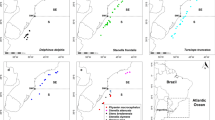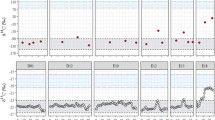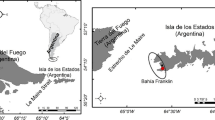Abstract
The Strait of Gibraltar is inhabited throughout the year by a group of pilot whales (Globicephala melas), but their spatial distribution varies between Summer and Autumn. In this paper, we have used carbon (13C/12C) and nitrogen (15N/14N) stable isotope signatures to investigate the differences in diet amongst seasons, sex and stable social units. Skin samples were collected from 56 individually photo-identified pilot whales during Autumn 2005 and Summer 2006. These individuals were genetically sexed and their isotopic signature determined. The level of inter-individual association both within and between stable social units were compared to Euclidean distances between individual isotopes signatures. No differences in either δ15N or δ13C were found according to the sex of individuals, but significant seasonal differences were found in δ15N, although not in the δ13C values. This suggests that pilot whales are resident year round in the Strait, a finding supported by independent photo-identification. The variation in δ15N could reflect a shift in pilot whale diet through the year, with pilot whales feeding at a higher trophic level in Autumn compared to Summer. This could also represent a change in the diet of pilot whale prey species. The δ13C values were significantly different amongst the four stable social units sampled and individual δ13C values were significantly related to the level of inter-individual association, while no relationship was found for δ15N. These results suggest that within the same general area (i.e. the Strait of Gibraltar), there is some level of specialisation in habitat or prey choice between pilot whales social units.





Similar content being viewed by others
References
Abend AG, Smith TD (1995) Differences in ratios of stable isotopes of nitrogen in long-finned pilot whales (Globicephala melas) in the western and eastern North Atlantic. ICES J Mar Sci 52:837–841
Abend AG, Smith TD (1997) Differences in stable isotope ratios of carbon and nitrogen between long-finned pilot whales (Globicephala melas) and their primary prey in the western north Atlantic. ICES J Mar Sci 54:500–503
Ackman RG, Eaton CA (1966) Lipids of the fin whale (Balaenoptera physalus) from North Atlantic waters. III. Occurrence of eicosenoic and docosenoic fatty acids in the zooplankter Meganyctiphanes norvegica (M. Sars) and their effect on whale oil composition. Can J Biochem 44:1561–1566
Aguiar dos Santos R, Haimvici M (2001) Cephalopods in the diet of marine mammals stranded or incidentally caught along southeastern and southern Brazil (21–34°S). Fish Res 52:99–112
Amos B, Hoelzel AR (1991) Long-term preservation of whale skin for DNA analysis. Genetic ecology of whales and dolphins. Rep Int Whal Comm. IWC, Cambridge, pp 99–103
Amos B, Barrett J, Dover GA (1991a) Breeding behaviour of pilot whales revealed by DNA fingerprinting. Heredity 67:49–55
Amos B, Barrett J, Dover GA (1991b) Breeding system and social structure in the Faroese pilot whale as revealed by DNA fingerprinting. Rep Int Whal Comm Spec Issue No. 13, pp 255–268
Amos B, Bloch D, Desportes G, Majerus TMO, Bancroft DR, Barrett JA, Dover GA (1993a) A review of the molecular evidence relating to social organisation and breeding system in the long-finned pilot whale. Rep Int Whal Comm Spec Issue No. 14, pp 209–217
Amos B, Schlötterer C, Tautz D (1993a) Social structure of pilot whales revealed by analytical DNA profiling. Science 260:670–672
Auger-Méthé M, Whitehead H (2007) The use of natural markings in studies of long-finned pilot whale (Globicephala melas). Mar Mammal Sci 23:77–93
Beatson E, O’Shea S, Ogle M (2007a) First report on the stomach contents of long-finned pilot whales, Globicephala melas, stranded in New Zealand. New Zea J Zool 34(1):51–56
Beatson E, O’Shea S, Stone C, Shortland T (2007b) Notes on New Zealand Mammals 6. Second report on the stomach contents of long-finned pilot whales, Globicephala melas. New Zea J Zool 34(4):359–362
Bjørke H, Gjøsæter H (1998) Who eats the larger Gonatus fabricii (Lichtenstein) in the Norwegian Sea? ICES, CM/M:10
Bloch D, Lockyer C, Zachariassen M (1993) Age and growth parameters of the long-finned pilot whale off the Faroe Islands. In: Biology of Northern Hemisphere Pilot Whales. Rep Int Whal Comm Spec. IWC, Cambridge, pp 163–208
Cañadas A, Sagarminaga R, de Stephanis R, Urquiola E, Hammond PS (2005) Habitat preference modelling as a conservation tool: proposals for marine protected areas for cetaceans in southern Spanish waters. Aquat Conserv 15:495–521
Christal J, Whitehead H, Lettevall E (1998) Sperm whale social units: variation and change. Can J Zool 76:1431–1440
Clarke M, Goodall N (1994) Cephalopods in the diets of three odontocete cetacean species stranded at Tierra del Fuego, Globicephala melaena (Traill, 1809), Hyperoodon planifrons (Flower, 1882) and Cephalorhynchus commersonii (Lacepede, 1806). Antarct Sci 6(2):149–154
Clarke MR, Santos MB, Pierce GJ (1998) The importance of cephalopods in the diets of marine mammals and other top predators. ICES CM 1998/M:8
Coleman DC, Fry B (1991) Carbon isotope techniques. Academic Press, New York
Davis RW, Fargion GS, May N, Leming TD, Baumgartner M, Evans WE, Hansen LJ, Mullin K (1998) Physical habitat of cetacean along the continental slope in the north-central and western Gulf of Mexico. Mar Mamm Sci 14(3):490–507
de Stephanis R (2008) Estrategias de alimentación de los diferentes grupos de calderón común en el Estrecho de Gibraltar. PhD thesis, University of Cadiz
de Stephanis R, Cornulier T, Verborgh P, Salazar Sierra J, Perez Gimeno N, Guinet C (2008a) Summer spatial distribution of cetaceans in the Strait of Gibraltar in relation to the oceanographic context. Mar Ecol Prog Ser 353:272–288
de Stephanis R, Verborgh P, Pérez S, Minvielle-Sebastia L, Guinet C (2008b) Social structure of long finned pilot whales (Globicephala melas) in the strait of Gibraltar. Acta Ethologica (in press)
Desportes G, Mouritsen R (1993) Preliminary results on the diet of long-finned pilot whales off the Faroe Islands. Rep Int Whal Commn. Special Issue No. 14, pp 305–324
Echevarría F, García Lafuente J, Bruno M, Gorsky G, Goutx M, González N, García CM, Gómez F, Vargas JM, Picheral M, Striby L, Varela M, Alonso JJ, Reul A, Cózar A, Prieto L, Sarhan T, Plaza F, Jiménez-Gómez F (2002) Physical–biological coupling in the Strait of Gibraltar. Deep-Sea Res Part II 49:4115–4130
Evans K, Hindell M (2004) The diet of sperm whales (Physeter macrocephalus) in southern Australian waters. ICES J Mar Sci 61:1313–1329
Flinn RD, Trites AW, Gregr EJ, Perry RI (2002) Diets of fin, sei, and sperm whales in British Columbia: an analysis of commercial whaling records, 1963–1967. Mar Mam Sci 18(3):663–679
Fullard K, Early G, Heide-Jørgensen MP, Bloch D, Rosing-Asvid A, Amos W (2000) Population structure of long-finned pilot whales in the North Atlantic: a correlation with sea surface temperature? Mol Ecol 9:949–958
Fullard K (2000) Microsatellite analysis of long-finned pilot whales. Ph.D. thesis, Cambridge University, Cambridge
Gannon DP, Read AJ, Craddock JE, Fristrup KM, Nicolas JR (1997) Feeding ecology of long-finned pilot whales Globicephala melas in the western North Atlantic. Mar Ecol-Prog Ser 148:1–10
Gil de Sola L (1993) Las pesquerías demersales del mar de Alborán (sur-mediterráneo ibérico), evolución en los últimos decenios. Inf Tec Inst Esp Oceanogr 142,179 pp
Ginsberg JR, Young TP (1992) Measuring association between individuals or groups in behavioural studies. Anim Behav 44:377–379
Guinet C, Domenici P, de Stephanis R, Barrett-Lennard L, Ford JKB, Verborgh P (2007) Killer whale predation on bluefin tuna: exploring the hypothesis of the endurance-exhaustion technique. Mar Ecol-Prog Ser 347:111–119
Hobson KA (1990) Stable isotope analysis of marbled murrelets: evidence for freshwater feeding and determination of trophic level. Condor 92:897–903
Hobson KA, Welch HE (1992) Determination of trophic relationships within a high Arctic food web using δ13C and δ15N analysis. Mar Ecol-Prog Ser 84:9–18
Hobson KA, Piatt JF, Pitocechelli J (1994) Using stable isotopes to determine seabird trophic relationships. J Anim Ecol 63:786–798
Hobson KA, Schell DM, Renouf D, Noseworthy E (1996) Stable carbon and nitrogen isotopic fractionation between diet and tissues of captive seals; implications for dietary reconstructions involving marine mammals. Can J Fish Aquat Sci 53:528–533
Hobson KA, Gibss LH, Gloutney ML (1997) Preservation of blood and tissue samples for stable-carbon and stable-nitrogen isotopes analysis. Can J Zool 75:1720–1723
Iverson SJ, Oftedal OT, Bowen WD, Boness DJ, Sampugna J (1995) Prenatal and postnatal transfer of fatty acids from mother to pup in the hooded seal (Cystophora cristata). J Comp Physiol B 165:1–12
Jankowski M (2005) Long-finned pilot whale movement and social structure: residency, population mixing, and indentification of social units. Master’s thesis, Department of Biology, Dalhousie Univesity, Halifax, Nova Scotia
Kelly JF (2000) Stable isotopes of nitrogen and carbon in the study of avian and mammalian trophic ecology. Can J Zool 78:1–27
Kinder TH, Parrilla G, Bray NA, Burns DA (1988) The hydrographic structure of the strait of Gibraltar. In: Almazan JL, Bryden H, Kinder T, Parrilla G (eds) Seminario sobre la oceanografía física del Estrecho de Gibraltar, SEGEC, Madrid, 24 – 28 October 1988, p 55–67
Kirsch PE, Iverson SJ, Bowen WD, Kerr SR, Ackman RG (1998) Dietary effects on the fatty acid signature of whole Atlantic cod (Gadus morhua). Can J Fish Aquat Sci 55:1378–1386
Kirsch PE, Iverson SJ, Bowen WD (2000) Effect of diet on body composition and blubber fatty acids in captive harp seals (Phoca groenlandica). Physiol Biochem Zool 73:45–59
Klem A (1935) Studies in the biochemistry of whale oils. Hvalrad Skr 11:49–108
Lacombe H, Richez C (1982) The regime of the Strait of Gibraltar. In: Nihoul JCJ (ed) Hydrodinamics of semi-enclosed seas. Elsevier, Amsterdam, pp 13–73
Lawson JW, Hobson KA (2000) Diet of harp seals (Pagophilus groenlandicus) in nearshore northeast Newfoundland: inferences from stable-carbon (δ13C) and nitrogen (δ15 N) isotope analyses. Mar Mamm Sci 16:578–591
Michener RH, Schell DM (1994) Stable isotope ratios as tracers in marine aquatic food webs. In: Lajtha K, Michener RH (eds) Stable isotopes in ecology and environmental science, pp.138–157
Morin Y, Lesage V (2003) Effects of dimethyl sulfoxide (DMSO) and lipid extraction methods on stable carbon and nitrogen isotope ratios in the skin of odontocetes and mysticetes. In: 15 conference of the society for marine mammalogy, Greensboro, NC, EEUU, December 2003
Ottensmeyer CA, Whitehead H (2003) Behavioural evidence for social units in long-finned pilot whales. Can J Zool 81:1327–1338
Parrilla G, Kinder TH, Bray NA (1988) Hidrología del agua mediterránea en el Estrecho de Gibraltar durante el Experimento Gibraltar (octubre 1985–octubre 1986). In: Seminario sobre la oceanografía física del Estrecho de Gibraltar SEGEC, Madrid, 24–28 de octubre 1988, pp 95–121
Reul A, Vargas JM, Jiménez-Gómez F, Echevarría F, Garcia-lafuente J, Rodriguez J (2002) Exchange of plantonic biomass through the strait of Gibraltar in late Summer conditions. Deep-Sea Res Part II 49:4131–4144
Rouvinen K, Kiiskinen T (1989) Influence of dietary fat source on the body fat composition of mink (Mustela vison) and blue fox (Alopex lagopus). Acta Agric Scand 39:279–288
Rosel PE (2003) PCR-based sex determination in Odontocete cetaceans. Conserv Genet 4:647–649
Sanjuán A, Zapata C, Álvarez G (1994) Mytilus galloprovincialis and M. edulis on the coasts of the Iberian Peninsula. Mar Ecol-Prog Ser 113:131–146
Santos MB, Clarke MR, Pierce GJ (2001) Assessing the importance of cephalopods in the diets of marine mammals and other top predators: problems and solutions. Fish Res 52:121–139
Sanz JL, Acosta J, Herranz P, Palomo C, San Gil C (1988) Mapa Batimétrico del Estrecho de Gibraltar. Proyecto Hércules 1980–1983, Instituto Español de Oceanografía
Shaw CN, Wilson PJ, White BD (2003) A reliable molecular method of gender determination for mammals. J Mammal 84:123–128
Sotiropoulos MA, Tonn WM, Wassenar LI (2004) Effects of lipid extraction on stable carbon and nitrogen isotope analyses of fish tissues: potential consequences for food web studies. Ecol Freshw Fish 13:155–160
Tieszen LL (1978) Carbon isotope fractionation in biological materials. Nature 276:97–98
Verborgh P, de Stephanis R, Pérez S, Jaget Y, Barbraud C, Guinet C (2008) Abundance and residency of long-finned pilot whales between 1999 and 2005 in the Strait of Gibraltar. Mar Mammal Sci (in press)
Wada E, Mizutani H, Minagawa M (1991) The use of stable isotopes for food web analysis. Crit Rev Food Sci Nutr 30:361–371
Zhao L., Castellini M., Mau T., Trumble S. (2004) Trophic interactions of Antarctic seals as determined by stable isotope signatures. Polar Biol 27(6):368–373
Acknowledgments
This project has been financed and subsidised by the General Direction for Biodiversity of the Spanish Ministry of Environment, the Autonomous City of Ceuta (Spain), the Foundation Loro Parque, the Fundación Biodiversidad, and the Nature Life Project LIFE02NAT/E/8610 “Conservation of cetaceans and turtles in Murcia and Andalusia” coordinated by the Sociedad Española de Cetáceos. The genetic analysis was supported by grants from the CNRS, the Ministère de la Recherche Scientifique, and La Fondation pour la Recherche Médicale/Fondation BNP-Paribas (to L.M.-S.). This work would not have been possible without the help of N. Seller Fernandez, J. Salazar Sierra, Z. Munilla, Y. Yaget, J. de la Fuente and D. Alarcon from CIRCE, and A. Baltanas, R. Redondo, V. Peiró and F José Caballero, from the Autonomous University of Madrid, and all the Whale watching platforms from the Strait of Gibraltar, WW España, Turmares SL, Aventura Marina and Firmm. This research was conducted using software Logger 2000 developed by the International Fund for Animal Welfare (IFAW) to promote benign and non-invasive research. Thanks are due also to A. Foote for the comments and the review of the English.
Author information
Authors and Affiliations
Corresponding author
Additional information
Communicated by R. Lewison.
Rights and permissions
About this article
Cite this article
de Stephanis, R., García-Tíscar, S., Verborgh, P. et al. Diet of the social groups of long-finned pilot whales (Globicephala melas) in the Strait of Gibraltar. Mar Biol 154, 603–612 (2008). https://doi.org/10.1007/s00227-008-0953-8
Received:
Accepted:
Published:
Issue Date:
DOI: https://doi.org/10.1007/s00227-008-0953-8




